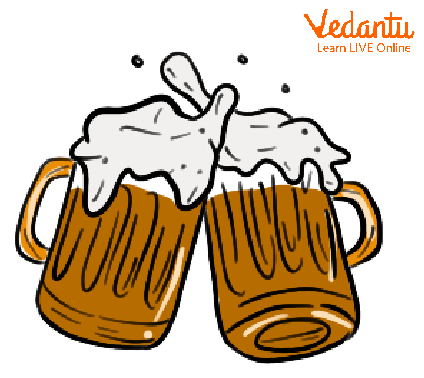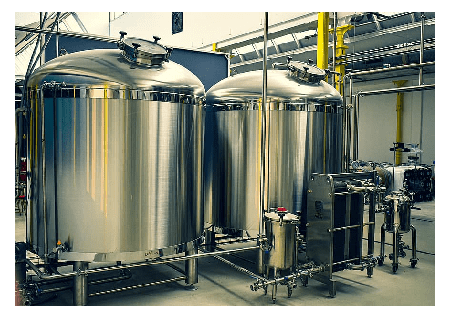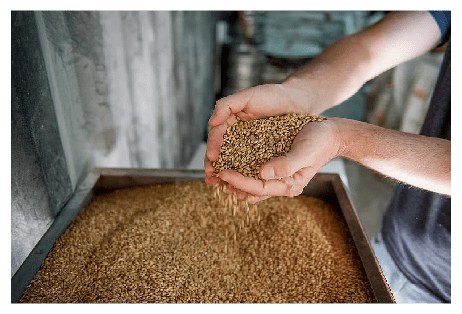




What is Beer?

Beer
Beer is considered one of the oldest alcoholic beverages in the world. After water and tea, it is the third most popular beer and is consumed on a larger scale. Beer is sold in bottles and cans and is also available on tap, especially in pubs and bars. The strength of modern beer is typically around 4% to 6% alcohol by volume but can vary from 0.5% to 20%. Beer is part of the culture of many countries and is associated with a rich pub culture with social traditions such as beer festivals and activities such as pub crawls, pub quizzes, and pub games.
It is made by brewing and fermenting starch, which is mainly derived from grains. Through the process, the fermentation of starch sugars in the wort produces ethanol and carbon dioxide in the resulting beer. Most modern beer is brewed with hops, which add bitterness and other flavour and acts as a natural preservative and stabiliser. In place of hops, other flavourings such as fruits, herbs, or fruits can be included or used.
The Beer Industry
The process of making beer is called brewing. A special building for beer production is called a brewery, but beer can be made at home and has a lot of its history. Historically, local beer was known as a farmhouse ale. The brewing industry is a global business made up of several powerful multinational companies and thousands of small producers ranging from pub breweries to regional breweries.

Brewery
The purpose of brewing is to convert the starch source into a sweet liquid called wort, and the wort is transformed in a fermentation process by yeast into an alcoholic beverage known as beer. The history of breweries in the 21st century has included larger breweries absorbing smaller breweries to ensure economies of scale.
The market for beer products and the beer industry is characterised by high prices and competitive pressure. In addition, the impact of the coronavirus on social life is still clearly noticeable, and its impact on the beer industry is becoming increasingly clear. The loss and waste of beer production should be avoided, and the system should be utilised optimally.
Production of Beer
The production of beer involves malting, grinding, mashing, extract separation, addition and boiling of hops, removal of hops and sediment, refrigeration and aeration, fermentation, separation of yeast from young beer, maturation, ageing, and packaging. The purpose of the entire process is to saccharify grain starch, extract sugar with water, and ferment it with yeast to make a carbonated drink with low alcohol content. Beer production involves certain steps, which are discussed below in detail:

Malt, Beer Production
Malting: The very first step involved in the industrial production of beer is malting. It modifies the barley into green malt, which is then preserved for drying. The whole process involves steeping the barley allowing it to germinate and dry the malt. For the malting process, specially bred strains of barley that are low in nitrogen are used. Each beer has its formulation of a blend of different malts.
Steeping: In the steeping process, the barley is drained and given air rest. For germination, a white root sheath, also called a chit, is broken down through the husk, and then the barley is removed from the steep.
Germination: The more germination progresses, the greater the change. Excessive modification leads to malt loss and reduced grain weight through root growth and plant respiration. In traditional malting, soaked barley is placed in piles called sofas and, after 24 hours, is spread out on the floor to germinate. Breathing grain absorbs oxygen and produces carbon dioxide and heat, so we achieved ventilation, aeration, and temperature control by manually rotating the grain.
Large floor maltings with mechanical turners were introduced, later replaced by pneumatic maltings. There, germination took place in boxes with automatically rotating beds, aerated, and forced air aeration. Salts are used to control root growth and malt loss. Traditionally, lagers have used less-improved malts, and ales have used well-improved malts, but whatever the intention of making a lager or ale, these are now well-improved malts.
Kilning: Green malts are dried to remove most of the water, leaving 5% in lagers and 2% in traditional ale malts. This process stops the enzymatic activity but leaves 40-60% active. Ageing at higher temperatures accelerates the reaction between amino acids and sugars to form melanoidins, which impart both colour and flavour to the malt.
Speciality malts are made by moistening green malts and heating them to high temperatures in closed tanks. It is used in small varying proportions (2-3% of the brewed malt), resulting in great colour and flavour variations in the finished beer. Chocolate malt and roasted sprouted barley are heavily used (25%) in the production of stouts and porters. The use of non-malted grains has also become popular. This is a cheap source of starch that can be used to dilute the malt colour and flavour, resulting in a fresher, lighter beer.
Modernisation: Modern malthouses can produce malt in four to five days, and technological advances have allowed precise control over temperature, humidity, and heat use. The Tower Malthouse is designed with the top floor for steeping and the bottom floor for germination and kilning, creating a fully automated, compact, semi-continuous operation.
Mashing: In the mashing process, the malt is mixed with water and the enzymatic conversion of starch into fermentable sugar is completed. After that, the aqueous extract known as the wort is separated from the residual spent grain.
Milling: For efficient extraction with water, the malt must be ground. While early milling processes used manual or water- or animal-powered stones, modern brewing uses mechanical roller mills. The design of the mill and the gap between the rollers are important for the correct grinding of malt. The goal is to break the friable modified starch into particles while keeping the shell relatively intact.
Case study
Do you think there are any health benefits to drinking beer? If yes, give an explanation to support your answer.
Ans: Beer has many health benefits when consumed in moderation. Anti-cancer properties Hops used in beer play an important role in fertilisation, including prostate cancer.
It also reduces the risk of cardiovascular disease as beer contains vitamin B6, preventing the compound from building up and heart disease.
Another advantage of beer is that it increases bone density and reduces osteoporosis and fracture risk.
Beer contains a good amount of folic acid and vitamin B12, which helps prevent diseases like anaemia and helps normal growth and concentration.
Summary
After water and tea, Beer is the third most popular beer and is consumed on a larger scale. Beer is sold in bottles and cans and is also available on tap, especially in pubs and bars. The beer industry is a major employment engine and economic engine. The industry supports more than 2 million US jobs and contributes more than $330 billion to the US economy, according to a 2020 Beer Serves America study. Unfortunately, the COVID-19 pandemic has dramatically reduced both employment and sales in the beer industry.
FAQs on Economics of Beer Processing: A Unique Analysis
1. Explain any three types of beer.
The types of beer are listed below:
Lager Beers are made with yeast that usually settles on the bottom of the container used, which results in a clear beer.
Ale beer is also one of the types made with yeast that floats and results in a cloudier beer. The alcoholic content of ale news is higher than lager beers.
Porter is considered a dark ale. The reason behind that darker colour is that before brewing, there is a process that involves the tossing of malt. This results in high alcoholic content and a stronger taste.
2. Explain the fermentation process which is used in making beer in detail.
Fermentation is the process whereby “sugars'' are converted by yeast to alcohol, carbon dioxide, and heat. In the brewing of most traditional beer, the sugars are derived mainly from malted barley, although other cereal sources and other plant sugars can also be used. These materials also contribute proteinaceous substances which, combined with the sugars and added flavouring agents, notably hops, generate the alcohol, flavours, and aromas that we know and love as beer. The fermentation system itself is made up of a cascading series of three stirred vessels and a fourth stirred vessel where the beer is separated from the yeast.
3. What is Brewing?
Brewing is the making of beer by soaking a starch source, usually a grain, most commonly barley, in water and fermenting the resulting sweet liquid with yeast. It can be done in a brewery by a commercial brewer, in a home by a brewer at home, or jointly. It has been brewed since around 6000 BC. And as per the archaeological evidence, it can be concluded that emerging civilisations brewed beer, including Mesopotamia and ancient Egypt. The brewing industry has been part of most Western economies since the 19th century.























